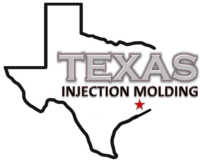Injection Molding Tool Shop
Texas Injection Molding operates an in-house full-service tool shop. The primary purpose of our tool shop is to provide routine maintenance of tooling to optimize performance in production. If production is interrupted due to a tooling issue Texas Injection Molding has all the tools necessary to complete the repairs quickly to minimize any production downtime. Should it be necessary to make engineering changes to production tools, we also have the capabilities to complete the most common modifications in house. Some of our capabilities include manual lathe and mill for making basic shapes and CNC for machining complex geometry. We also have EDM capabilities which allows us to complete precision work on mold features. Finally, we also have surface grinding and welding capabilities.
Injection Molding Core Pulls
Today we will demonstrate the use of the machine core pull feature. The core pull feature on an injection molding machine uses the hydraulic pressure from the machine and a valve that is timed to operate a hydraulic cylinder. This first illustration is called a reverse ejection where the part is filled and ejected from the core side of the mold to ensure no witness marks from injection point or ejector pins are visible on the cavity or cosmetic surface of the part. Following injection of the plastic from the core side or non-cosmetic side, we utilize the core pull feature on the molding machine to operate cylinders mounted to the mold to eject the part. This mold design allows the part to be ejected without leaving ejector pin marks on the cavity or cosmetic surface of the part. The second illustration demonstrates how to automate the molding of internal threads on a part. The mold is designed with a unscrewing mechanism that turns the core while the mold is opening. The unscrewing mechanism is timed and driven by the core pull feature on the machine. This mold design allows the mold to open and remove the part from the core leaving internal threads on the part.
Injection Molding Polishing
Gloss levels are typically specified as part of the cosmetic requirements of a plastic injection molded part. There are standards that have been developed and published by the Society of Plastic Industry for mold polish. The finishes range from a D1 – dull finish that is created by blasting the surface of the injection mold cavity with a dry powder and is relatively inexpensive to a A1 – mirror polish that is created by progressive polishing of increasing grit from stone to paper to diamond. Polishing the surfaces of the steel is labor intensive and is a real specialty. This video demonstrates the craftsmanship in hand polishing an injection mold cavity.
Master Control Plan
In order to manufacture a part to specifications in a job shop environment the injection molder must have a consistent and dependable process and maintain all the information necessary for the mechanical, cosmetic and packaging specifications readily available. At Texas Injection Molding we document a Master Control Plan for every part and maintain this information at the molding machine during manufacturing. The master control plan contains the part print and tolerances, material specifications, operating instructions, Cosmetic specifications, Process Recipe, work station set up instructions, and quality inspection plan. We also maintain first shot approval and last run production shot for production records and reference for tooling maintenance or repairs.
EDM - Electrical Discharge Machining
Electrical discharge machining, or EDM, shapes metal by creating sparks that melt tiny portions of the workpiece, and is an exceptionally diverse process that generates no cutting forces. EDM is especially useful in the production of fragile parts and sharp inside corners that cannot take the stress of conventional machining. This video is demonstrating a sinker EDM cutting a core for an injection mold.
